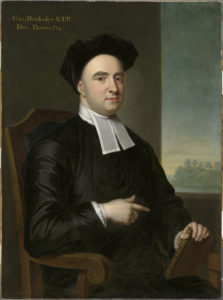|
Getting your Trinity Audio player ready...
|
Connexion of the Sensible and the Abstract

Some things are perceived by the senses immediately, some mediately, with the intervention of others. The latter may be signified and suggested to the mind by sensible marks, with which they have an arbitrary connexion. For instance, in reading a book, what I immediately perceive are the letters; but mediately, or by means of these, the notions of justice, virtue, truth, etc.
Philosophers divide sensible qualities into primary and secondary. The former are Extension, Figure, Gravity, Motion, and Rest; and these they hold exist really in bodies. The latter are sound, color, etc., which they assert are only sensations or ideas existing nowhere but in the mind.
If no idea can exist in an unperceiving substance, then surely it follows that no figure, or mode of extension, which we can either perceive, or imagine, or have any idea of, can be really inherent in Matter, or anything that does not perceive it; It is impossible for the mind to disunite the ideas of extension and motion from all other sensible qualities, where the one exist there necessarily the other exist likewise.
Connexion and Relativity
Time is measured by the succession of ideas in our minds. Consequently the same body may to one person seem to perform its motion over any space in half the time that it doth to another. And the same reasoning will hold as to any other proportion.
Motion and Sensation
We are chained to a body: that is to say, our perceptions are connected with corporeal motions. By the law of our nature, we are affected upon every alteration in the nervous parts of our sensible body; The sensible body is nothing but a complexion of qualities or ideas perceived by a mind. So that this connexion of sensations with corporeal motions means no more than a correspondence in the order of nature, between two sets of ideas, or things immediately perceivable. But God is a Pure Spirit, disengaged from all such sympathy, or natural ties. No sensations of pain or pleasure attend corporeal motions in His mind.
Connexion of Ideas
Men combine together several ideas, apprehended by divers senses, or by the same sense at different times, or in different circumstances, but observed to have some connexion in nature, either with respect to co-existence or succession; all which they refer to one name, and consider as one thing. When I examine, by my other senses, a thing I have seen, it is not in order to understand better the same object, for the object is different. My aim is only to know the connexion of ideas, the nature of things.
Objection
How it is possible there should be room for all those trees and houses to exist in your mind. Can extended things be contained in that which is unextended? Or, are we to imagine impressions made on a thing void of all solidity? You cannot say objects are in your mind, as books in your study: or that things are imprinted on it, as the figure of a seal upon wax. In what sense, therefore, are we to understand those expressions?
Related Posts:
References:
- Berkeley, George. “Three Dialogues Between Hylas and Philonous” Project Gutenberg. December 01, 2003. Accessed January 18, 2018. http://www.gutenberg.org/ebooks/4724
